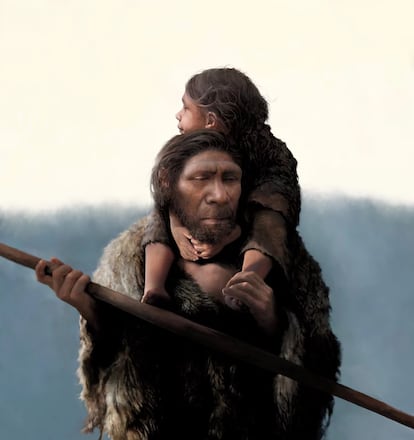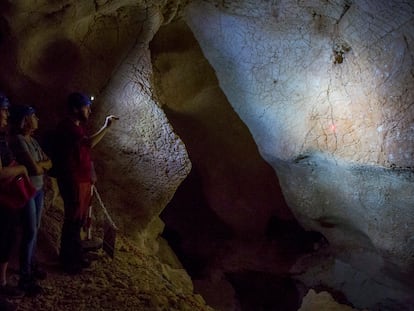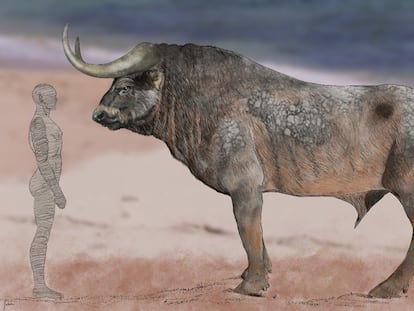DNA sequencing finds first known Neanderthal family, including a father and daughter
The genetic profile of 13 individuals found in two Siberian caves confirms that some 54,000 years ago, these relatives of ‘Homo sapiens’ lived in very small groups and were weighed down by inbreeding

A team of European scientists has just obtained the oldest known family “portrait” of ancient human ancestors. This portrait is in fact a genetic profile extracted from the bones of 13 individuals found in two caves in Siberia, Russia. The DNA recovered from these fossils shows that two of these individuals were a father and his teenage daughter. At least two other individuals are the male individual’s relatives, a young child and an adult woman who could have been his cousin and grandmother. They were all Neanderthals, the human species most closely related to our own and which mysteriously became extinct about 40,000 years ago. The finding provides the most detailed portrait to date of what Neanderthal groups were like, and confirms key data to understand why they disappeared forever.
The human remains come from Chagyrskaya and Okladnikov, two caves in southern Siberia where Neanderthals lived about 54,000 years ago. Stone tools and the remains of animal bones show that they were nomads who lived by chasing their usual prey: bison, horses and mountain goats. At that time, this was a border territory. To the west lived the European Neanderthals, and less than 100 kilometers away were the Denisovans or Asian Neanderthals. The study of DNA extracted from fossils in previous studies has revealed that these two species and Homo sapiens met and had hybrid children. It’s a mystery why only Homo sapiens survived.
A team of scientists led by Svante Pääbo, from the Max Planck Institute for Evolutionary Anthropology (Germany) and winner of this year’s Nobel Prize for Medicine, was able to recover a large part of the genome of the 13 Neanderthals from the two Siberian caves and compare it with that of other 18 previously discovered Neanderthals.
The results, published today in Nature, a reference in world science, show that several of the individuals found in Chagyrskaya lived at the same time and in the same place, an unusual finding in sites this old. The two residents of Okladnikov, about 100 kilometers to the east, were not direct relatives, but at least one of them could also have been a contemporary of the other clan. The genetic variability of these remains suggests that the Neanderthal groups were small, made up of between 10 and 20 individuals.
The study shows that the mitochondrial genome passed from mother to child was much more varied than that of the Y chromosome passed on by fathers. This confirms that in Neanderthal societies women left their families to go and live with other groups and bear children, while men stayed put in the same clan. It is a common practice in many current hunter-gatherer societies that prevents diseases and sterility associated with inbreeding.
Antonio Rosas, paleoanthropologist at Spain’s National Research Council (CSIC), highlights that these conclusions are very similar to those advanced by his team in 2011. In this case, they analyzed only the mitochondrial genome of six adults, three adolescents, two children and a Neanderthal baby who died devoured by other hominins of its kind and whose remains were found in the cave of El Sidrón, in the northern Spanish region of Asturias. The DNA showed that they were related by maternal lineage, but it was impossible to say by how much. It did show that they were small and very isolated groups in which the females were the ones who left their clan for other social groups. “This is a very common practice among many groups of Homo sapiens and also in other primates to maintain genetic variability,” explains Rosas.

Despite this strategy, the Neanderthal family of Chagyrskaya already seemed doomed to disappear in a few generations. Researchers have studied the genetic variability among all individuals and the level of identical sequences is as high as among current mountain gorillas, one of the most endangered species on the planet.
The results also indicate that these Neanderthals were from the dominant Western European lineage and had no trace of interbreeding with their Asian Denisovan neighbors, despite living just 100 kilometers away. These data support that isolation and inbreeding contributed to the extinction of these hominins.
The big question is whether the Homo sapiens of that time were different from their Neanderthal cousins, both genetically and socially. It is difficult to know, since there are hardly any sapiens fossils from this time and no DNA has been recovered to obtain a family genetic portrait. “It is evident that they must have had something that was different, perhaps a different strategy to build ties between groups, or maybe they were clans with more members,” ventures Carles Lalueza-Fox, a geneticist at the CSIC.
Tu suscripción se está usando en otro dispositivo
¿Quieres añadir otro usuario a tu suscripción?
Si continúas leyendo en este dispositivo, no se podrá leer en el otro.
FlechaTu suscripción se está usando en otro dispositivo y solo puedes acceder a EL PAÍS desde un dispositivo a la vez.
Si quieres compartir tu cuenta, cambia tu suscripción a la modalidad Premium, así podrás añadir otro usuario. Cada uno accederá con su propia cuenta de email, lo que os permitirá personalizar vuestra experiencia en EL PAÍS.
¿Tienes una suscripción de empresa? Accede aquí para contratar más cuentas.
En el caso de no saber quién está usando tu cuenta, te recomendamos cambiar tu contraseña aquí.
Si decides continuar compartiendo tu cuenta, este mensaje se mostrará en tu dispositivo y en el de la otra persona que está usando tu cuenta de forma indefinida, afectando a tu experiencia de lectura. Puedes consultar aquí los términos y condiciones de la suscripción digital.
More information
Archived In
Últimas noticias
Most viewed
- David King, chemist: ‘There are scientists studying how to cool the planet; nobody should stop these experiments from happening’
- Reinhard Genzel, Nobel laureate in physics: ‘One-minute videos will never give you the truth’
- Oona Chaplin: ‘I told James Cameron that I was living in a treehouse and starting a permaculture project with a friend’
- Mexico completes its trade shift with the entry into force of tariffs on China and countries without trade agreements
- Sinaloa Cartel war is taking its toll on Los Chapitos











































